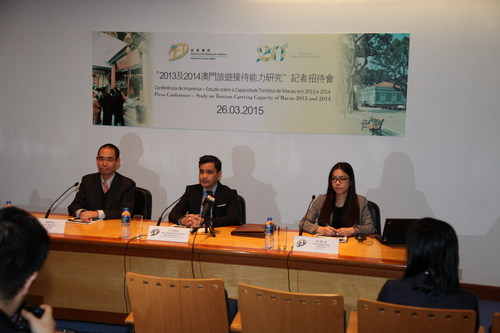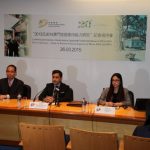 IFT Research Team hosts the press conference
IFT Research Team hosts the press conference
Background 1. First commissioned by the Secretariat for Social Affairs and Culture in 2003, the Institute for Tourism Studies (IFT) has been conducting the annual Tourism Carrying Capacity (TCC) study. The objective of the study is to determine the optimum number of visitors that Macao can receive per day. Methodology 2. There are several and varying methods for assessing a tourism destination’s optimal capacity to receive visitors. In Macao’s case, IFT adopts two approaches for determining the optimum number of visitors. The first approach is based on the concept of social carrying capacity (SCC), which uses subjective measures perceived and experienced by residents and visitors. The second approach assesses changes in the physical carrying capacity (PCC) of key tourism infrastructure and physical facilities. 3. The SCC approach estimates optimum carrying capacity based on Macao residents’ satisfaction with factors affecting their quality of life and visitors’ satisfaction with the quality of their visiting experience. These subjective factors include (a) perceived level of crowdedness, (b) satisfaction with the quality of the environment, (c) satisfaction with transportation services, (d) service quality and (e) waiting time at food and beverage as well as retail outlets, (f) satisfaction with tourist attractions as well as recreational activities, (g) satisfaction with border immigration clearance. Visitors also provide their satisfaction (h) hotel service performance and (i) availability of hotel rooms. Multiple regression modeling of the relationship between these factors and daily visitor numbers help determine an estimated optimum capacity. 4. Data for the SCC approach is collected via an extensive field survey conducted throughout the year. Results for 2013 is based on data collected from 6,005 respondents (of which 2,987 were residents and 3,018 visitors). For 2014, survey data were obtained from 6,007 respondents (2,991 residents and 3,016 visitors). 5. The PCC approach evaluates the physical and service carrying capacities of eight major tourism-related infrastructures and services. These include (a) hotel accommodation, (b) restaurant and dining facilities, (c) public buses, (d) taxis, (e) ferries, (f) border immigration clearance, (g) major non-paid visitor attractions, and (h) inbound tour operations. IFT collects data directly from organizations that manage, operate, or utilize the above facilities to gauge their physical service capacity to service residents and visitors. Findings 6. Based on IFT’s latest analysis using a social carrying capacity (SCC) approach, the estimated optimum carrying capacity of Macao for 2013 and 2014 are as follows: (* Please find attached file) 7. In terms of physical carrying capacity (PCC) several tourism services and facilities were able to increase their capacity to service visitors in 2013 and 2014 but there were also setbacks. a. Ferry services, inbound tour operating services, and border immigration clearance were able to maintain adequate or augment capacity to handle increased visitor numbers. b. The total number of hotel rooms is currently below the optimum number of visitors and may be inadequate particularly during peak periods but additional accommodations are in the pipeline from properties currently in development or planned. c. The physical capacities of transportation, especially taxis and public buses, remain strenuous. For example, there were reductions in the number of taxis in operations but several new licenses have been issued and additional ones are planned soon. As more visitors utilize the public taxis and buses as a means for transportation, the risk for a further squeeze will be likely, as residents and visitors share both transport facilities. d. Macao’s major visitor attractions and restaurants and dining establishments also face capacity issues. There are certain periods during the year in which service capacities of these sectors are adequate but on other days could be insufficient to meet the demand. Discussion 8. Compared to previous years, Macao’s tourism carrying capacity (based on the SCC approach) has increased in a stable manner, but reached a highpoint in 2013 and showed a leveling off in 2014. This trend suggests that Macao’s capacity to absorb visitors may have reached a saturation point in 2014. From a social perspective, this is likely due to residents’ beginning to grow weary of the effects of continued tourism growth on important quality of life issues such as deteriorating experience with public transport and perceived crowding in the street as well as deterioration in visitors’ travel experience caused by over-crowdedness and possible decline in tourism service quality in F&B and retail outlets as well as immigration borders. 9. Though critical measures were taken in 2014 to augment capacity in several areas (e.g., increasing the opening time of the border entry points, adding new taxi licenses) and crowd control measures during peak periods of visitation like the Chinese New Year golden week holiday period, the effects of these improvements were not proportional enough to the continued increase in the number of visitors especially on some peak days. Thus it is likely that both residents and visitors perceive an overall deterioration in overall conditions. About the annual TCC Study 10. Different methods for assessing a destination’s tourism carrying capacity will lead to different estimates, depending on the assumptions and techniques adopted. IFT will endeavor to explore other complementary methods to assess Macao’s tourism carrying capacity in order to provide accurate and reliable information and taking into account as many perspectives as possible for supporting better policy formulation and enhancement of Macao’s tourism development. 11. The TCC study is a retrospective study—it does not seek to impose future boundaries or limits to Macao’s tourism. It serves to indicate at which levels of visitor numbers were residents’ and visitors’ experience affected and thus provide important inputs to future planning and policy. Recommendations 12. To improve and enhance Macao’s tourism carrying capacity in the long run, the following general policy directions can be explored or discussed: a) It is important that physical capacity growth of key infrastructure and facilities is coordinated, balanced, and synchronous. Additional room capacity provided by recent (and upcoming) new hotel properties, for example, will not prove efficient if there is no corresponding increase or enhancement in other areas such as public transport and improvements in service quality. b) In the near future, it is highly recommended that measures be taken to moderate and balance the growth in visitor numbers so that it is managed in a stable method, avoiding any rapid surge or decrease. c) Greater selectivity in target source markets to achieve diversity and quality. d) Continued expansion of service infrastructure and facilities as well as availability and diversity of attractions. e) Encourage variations and coordination in the opening hours or periods of selected attractions as well as the scheduling of events in order to distribute demand more evenly throughout the year and throughout each day. f) Define certain zones for long-term development, delineating clearly areas where tourism development can be more concentrated as well as segregated from residential areas. g) Develop facilities or zones to cater to the needs of frequent cross-border shoppers, many of who visit Macao for one day, in order to reduce congestion at key areas of the city.


